People Strategy: What Is It and How to Make One
A people strategy is a company’s approach to recruiting, retaining, and engaging its workforce to be aligned with business goals.

Picture this: you have a profitable company that can draw new talent any day. But, if your employees often feel unhappy often and come and go, you’ll start facing problems soon. It’s no secret that to be successful you need an engaged and motivated team. An effective people strategy is the key to making that happen.
Many companies claim they’re investing in more strategies like employee engagement and employee experience. But the reality might be quite different. A study published by Gartner in 2021 showed that people-centric policies are still lacking. That’s true whether employees work remotely, on-site, or have a hybrid schedule.
The same study showed that human-centric policies lead to better performance. People are more satisfied with their job and are less likely to leave.
One thing is certain—having an effective people strategy is crucial to the success of a business. So, let’s take a look at what a people strategy is, and how to build one.
What is a people strategy?
A people strategy is a company’s approach to recruiting, retaining, training and engaging its workforce. The goal is to make sure employees are aligned with the business goals. After all, businesses are made of people and need people to be successful.
Through a set of human-centric guidelines, you need to determine ways to develop talent, promote diversity and inclusion, improve leadership, and more.
A people strategy shouldn’t be confused with an HR strategy. The HR strategy is all about managing employee logistics: recruiting, evaluating, compensating, and more. People strategies, on the other hand, are about the relationship an organization has with its employees.
How do you build a people strategy?
According to recent studies, 69% of employees say that feeling appreciated helps them work harder. And a good people strategy is key to making that happen.
Developing a people strategy isn’t a task that belongs to HR leaders alone. On the contrary, it needs to involve everyone at a C level, line managers, and even the financial department.
You’ll need to have a clear goal in mind. But you also need flexibility and a willingness to constantly improve.
5 steps for building an effective people strategy
1. Gather data
To build a successful people strategy, start by gathering data and defining the results you want to see. Data can refer to turnover rate, sick days, and more. It should also refer to diversity—things like gender ratio, employee age, etc.
Stay consistent with the evaluation methods you use to gather data, to ensure there are no discrepancies.
Don’t forget to gather data from the leadership team as well. You can use surveys, interviews, or anything that will help you have as much reliable information as possible.
This will help you identify the problems your current people strategy may have. It will also be essential in helping you define the desired business outcomes and goals. In the long term, gathering and using this data can help close the People Impact Gap.
2. Focus on learning and development
A good people strategy that helps you achieve business goals needs to include a learning and development plan.
A 2020 LinkedIn study showed that having more opportunities to learn new skills would motivate 73% of employees to stay at their current organization.
Training can—and should—go beyond classic mandatory training. It can include mentorship programs, coaching, upskilling programs, and more.
People have different learning styles. What motivates and helps one person grow, might do the opposite for another. That’s why it’s crucial to have a few options at hand to adapt to each person’s needs.
3. Foster a diverse and inclusive environment
Speaking of the diversity of learning styles, a diverse and inclusive environment should be one of your primary goals.
You need to create a space that is safe for everyone, where people feel included and respected. Make sure everyone has equal opportunities and nobody feels like they’re behind a glass ceiling.
Communication is key. Ask for feedback. You should already have feedback on your people strategy from everyone in HR, the C-suite, and line managers. Now take it one step further. Gather feedback from investors, and most importantly, get employee feedback.
4. Establish business priorities and purpose
Effective people strategies must be purpose-driven. A sense of purpose equips executives to better respond to disruptions. And, according to a 2020 study conducted by EY, it also boosts performance and engagement.
But to have positive results, there’s one thing you need to do after establishing your priorities: share them with the organization. Every person in your company must be aware of the business strategies and goals. After all, what use is a good strategy if no one knows about it?
5. Track results and adjust your strategy as needed
Creating and implementing your people strategy is just the beginning. Once you’ve implemented your people strategy, you need to carefully track and analyze the results.
Make sure you’re reaching your goals. Be prepared to adjust your strategy as needed, until you reach the desired outcome. A people strategy should never be static. Be on the constant lookout for feedback and ways in which you can improve it.
10 examples of people strategy
Now that we’ve covered the most important steps to take to build an effective people strategy, let’s take a look at a few examples.
1. Spotify
As the Spotify team says, their people strategy is based on purpose, adding business value, and putting people first. They have created a diverse team, and prioritize inclusion and equal opportunities. They also put a strong emphasis on learning, development, and personal growth.

Source: hrblog.spotify.com
2. Kincentric
Kincentric uses something called Agile People Strategy Framework. It helps them prioritize constant improvement. They use both human resources and organizational solutions to achieve their goals faster.
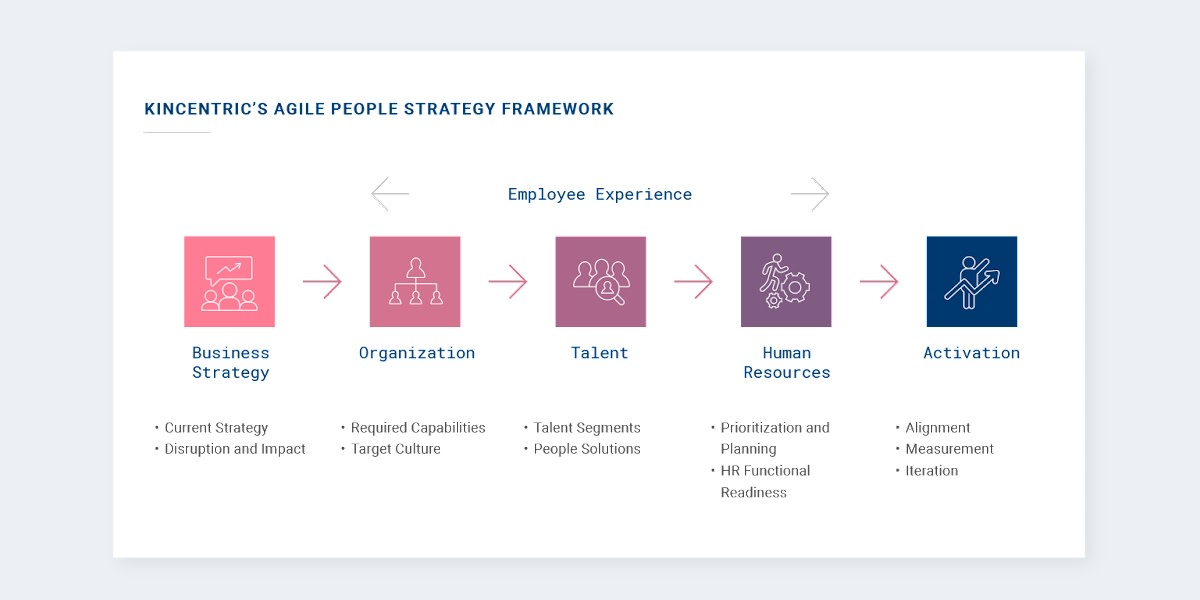
Source: kincentric.com
3. Adidas
Adidas is a great example of a company that combines diversity, inclusion, and individual growth in its people strategy. They base their strategy on what they call the “four pillars”: talent acquisition, role model leadership, diversity and inclusion, and company culture.
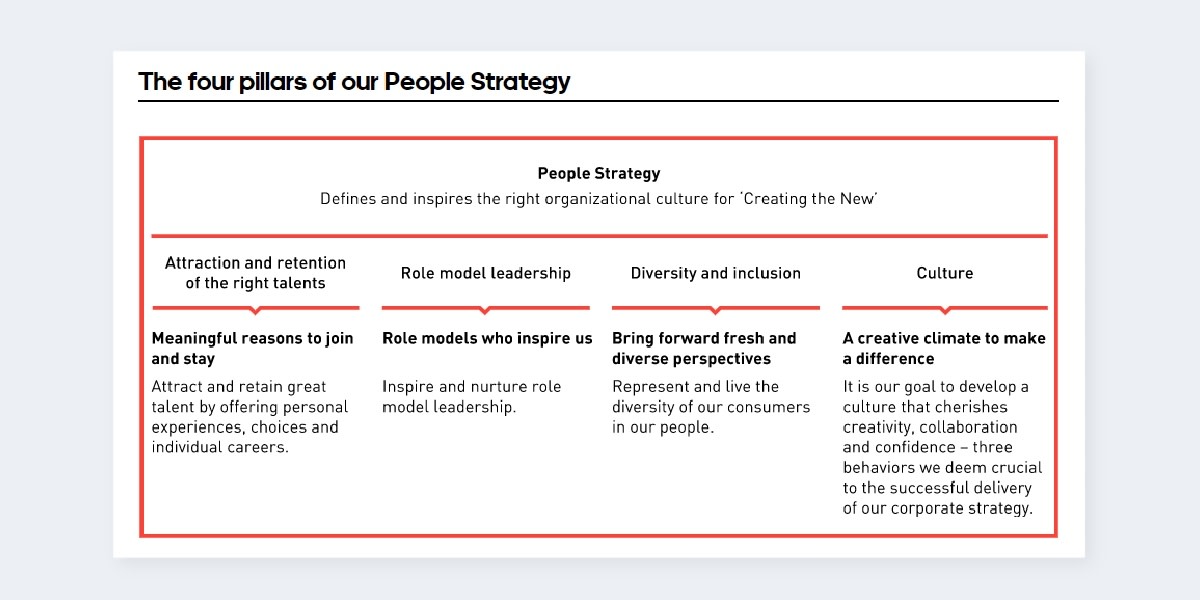
Source: report.adidas-group.com
4. Albatross Group
Albatross has a people strategy based on talent and performance management, development, and rewards. Their goal is to ensure that everyone from every department goes through the same processes and has equal opportunities.

Source: albatrossgroup.com
5. Meyer Advisory
A good example of how business and people strategies work together for optimal business results can be seen in Meyer Advisory’s model below. Their main areas of focus include planning, acquisition, rewards, and development. Something that sets this people strategy apart from the ones we’ve seen before is that it is combined with the human resource strategy.
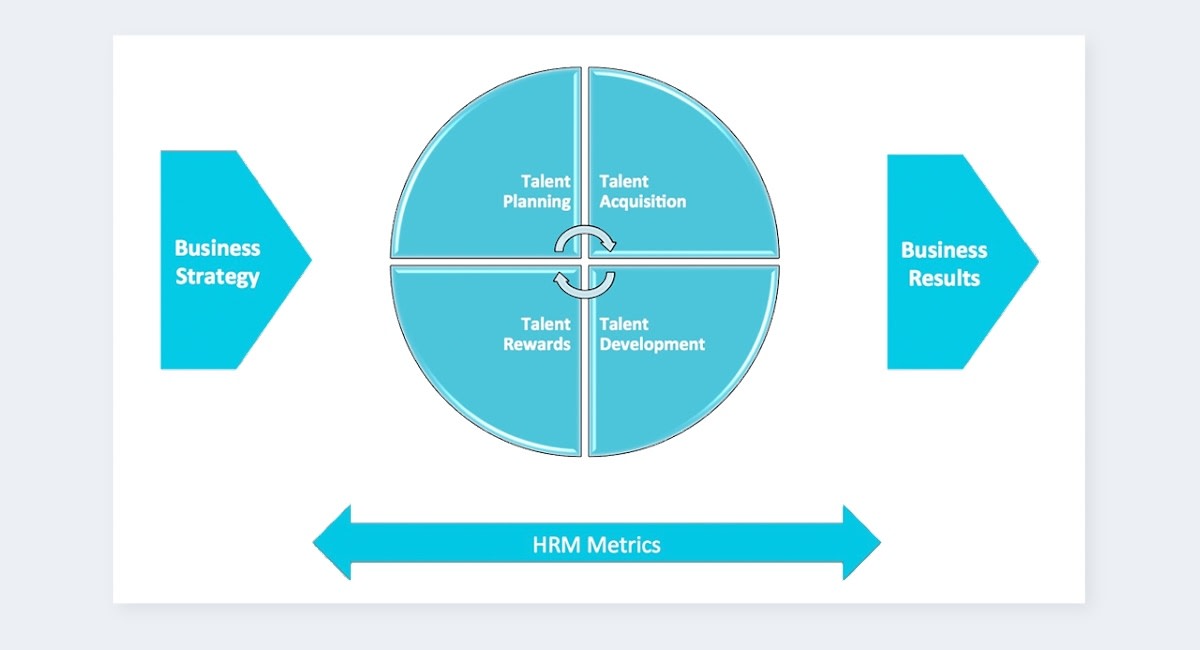
Source: meyeradvisorygroup.com
6. Epsom and St Helier University Hospital NHS Trust (ESTH)
People strategies aren’t only for big tech or HR companies, and ESTH proves it. They aim to attract and retain people who are aligned with their vision of healthcare. They help their staff reach their full potential by encouraging upskilling, as well as through an emphasis on wellbeing and mental health care.

Source: epsom-sthelier.nhs.uk
7. Safe Work Australia
Another people strategy that prioritizes learning and development, diversity, inclusion, as well as rewards can be seen at Safe Work Australia. On top of the standard ideas included in such strategies, SWA includes health, safety, and wellbeing as one of its pillars.
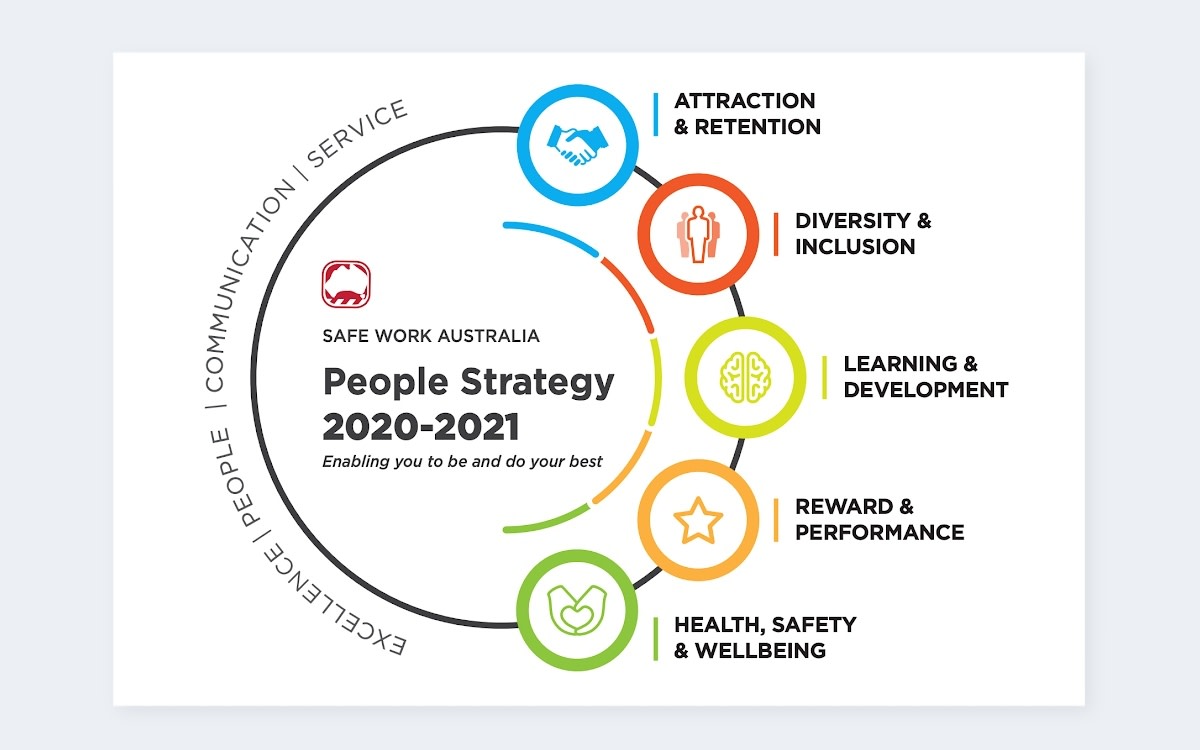
Source: safeworkaustralia.gov.au
8. Health Services (HSE)
HSE uses a framework based on both its vision and its mission to craft its people strategy. It includes leadership, inclusion, talent acquisition, and more, in order to build an effective plan that will help them reach their business goals.

Source: hse.ie
9. Gotham Culture
Gotham Culture’s strategy starts with an assessment and data gathering. It continues with dialogue and feedback. Only after these steps are complete is the strategy built and implemented.
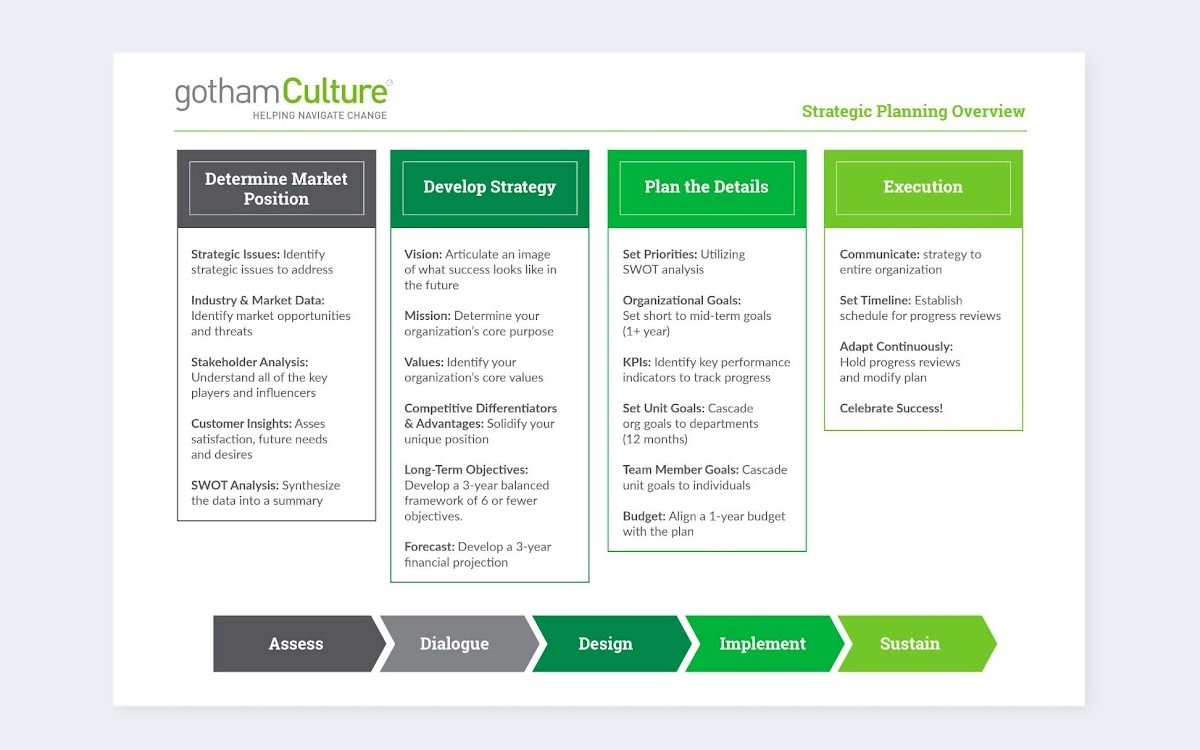
Source: gothamculture.com
10. Generic six pillar people strategy
We end our list with a generic example of a strategy built on 6 main pillars:
Culture building
Leadership
Engagement and development
Team dynamic
Organizational capabilities
Performance maximization
All the pillars are interconnected. If one doesn’t work well or is skipped, the others might not work either.
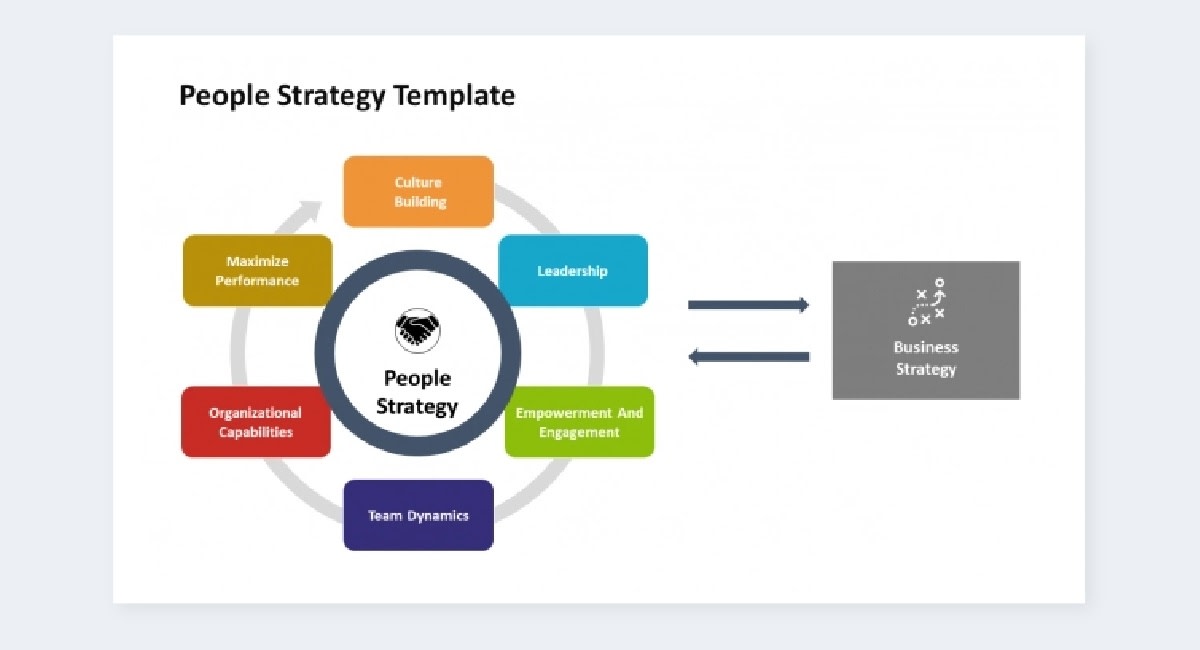
Source: slideegg.com
Bottom line
A solid people strategy is the way to go if you want to attract and retain employees who are aligned with your business values. People who feel valued and who have opportunities to grow are more likely to remain in a company.
There are no shortcuts when it comes to creating a people strategy. You’ll need to gather data, pay attention to your employees, who they are, what they do, and what motivates them. Engagement, learning, development, and inclusion will also help ensure your people strategy is effective and aids you in achieving your business goals.
Get Outsmart content straight to your inbox
Subscribe to the People Insights Monthly newsletter for actionable insights and stories.
Subscribe now